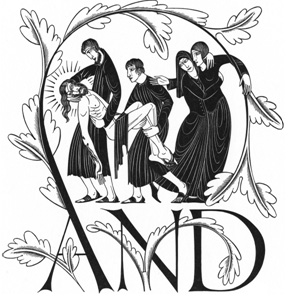News
FOR IMMEDIATE RELEASE
Steve Christensen
LUMA
312.915.6164
schris6@luc.edu
Spring Exhibition Line Up
 |
CHICAGO, February 3, 2011 – The Loyola University Museum of Art (LUMA) will open Eric Gill: Iconographer on Saturday, February 12. Eric Gill (1882–1940), best known for his typography and the widely used typeface that bears his name, was a prolific English artist and writer whose daring aesthetic combined sensuality and spirituality with a keen sense of line. His artistic works range from postage stamps to stone monuments.
Drawn from the Albert Sperisen Collection at the University of San Francisco, the more than 100 works in Eric Gill: Iconographer, which are on display through Sunday, May 1, are predominantly wood engravings completed between 1910 and 1940. Gill carved these engraved images on boxwood, which were then printed in limited editions using letterpress. The original engraving blocks, publications, and books are also on display.
About the Artist
“The artist is not a special kind of man, but every man is a special kind of artist.” –Eric Gill, Christianity and the Machine Age, 1940
At age 21, Gill gave up formal studies in sacred architecture to pursue calligraphy, stone cutting, and masonry—crafts he utilized throughout his career. Identified on his own tombstone as a stone carver, he was one of England’s most sought-after headstone carvers and received commissions for important stonework and sculptures at Westminster Cathedral, the BBC Headquarters, and the League of Nations building in Geneva.
Between 1925 and 1931, Gill designed his best-known typefaces: Perpetua, Gill Sans, and Joanna, the last named for his daughter. He was appointed a Royal Designer for Industry, the highest British honor for designers. During his lifetime, Gill wrote and published numerous books on art, religion, and society, including An Essay on Typography in 1931 and Autobiography in 1940. His most celebrated artworks include sculptures and refined wood engravings, as well as drawings. His subjects range from fashion to literature and the sensual to the religious. His iconographic designs and commitment to craftsmanship demonstrate a strong influence from the English Arts and Crafts movement (1880–1910) and artists such as textile designer William Morris (1834–1896). Along with two peers, he founded the Guild of St. Joseph and St. Dominic in order to unite artisans in a religious association.
A controversial and conflicted figure, Gill was deeply religious and influenced by medieval Catholicism, yet crossed every lay imaginable boundary in his private life. An advocate of free love and Fabian socialism while a lay member of the Third Order of St. Dominic, Gill had utopian dreams of recreating medieval guilds of artists, yet often worked in self-imposed isolation. The deeply spiritual and overtly sensual are regularly intermixed throughout his work. The engravings in Eric Gill: Iconographer embody these tensions while revealing the elegant boldness that defines his aesthetic.
The University of San Francisco’s Albert Sperisen Collection
Acquired by the University of San Francisco in 1971, the Albert Sperisen Collection focuses on Gill’s wood engravings. These works include early bookplates, family portraits, erotica, religious scenes, and illustrations for fine press editions of the Four Gospels, The Canterbury Tales, and Troilus and Criseyde, among others. Co-curated by Thomas Lucas, S.J., gallery director, and Stuart McKee, design professor, Eric Gill: Iconographer presents 100 of the most representative engravings in the collection, as well as original woodblocks and Gill publications.
Public Programs:
Opening Reception for Eric Gill: Iconographer
Friday, February 11, 5:30 p.m. to 7:30 p.m.
LUMA Members and Loyola Faculty, Staff, and Students: Free
Non-Members: $15
Saint and/or Satyr? The Graphic Legacy of Eric Gill
Tuesday, April 5, 6 p.m.
Free admission for everyone
Thomas Lucas, S.J., director of the Thacher Gallery at the University of San Francisco (USF) and current scholar in residence at Loyola, will explore the graphic legacy of Eric Gill in this tour. Borrowed from the USF’s Donohue Rare Book Room and organized by the USF’s Thacher Gallery, the exhibition of more than 100 prints, drawings, books, and wood blocks presents the paradoxical personality and startling breadth of Gill’s troubled genius, ranging from the profoundly religious to the extremes of sensuality.
Please RSVP for these events by sending an e-mail to luma@luc.edu or by calling 312.915.7608. All events will be held at LUMA, 820 N. Michigan Avenue, Chicago, Illinois.
About LUMA
Opened in 2005, the Loyola University Museum of Art is dedicated to exploring, promoting, and understanding art and artistic expression that illuminates the enduring spiritual questions of all cultures and societies. As a museum with an interest in education and educational programming, LUMA reflects the University’s Jesuit mission and is dedicated to helping people of all creeds explore the roots of their faith and spiritual quests. Located at Loyola University Chicago’s Water Tower Campus, the museum occupies the first three floors of the University’s historic Lewis Towers on Chicago’s famous Michigan Avenue. For more information, visit the museum’s website at LUC.edu/luma.
Art illuminating the spirit!
-LUMA-

